Dell Precision M6700 Notebook Review: The Enterprise Split
by Dustin Sklavos on December 12, 2012 7:43 PM ESTApplication and Futuremark Performance
The Intel Core i7-3920XM CPU that powers our Dell Precision M6700 review unit isn't just the fastest notebook CPU we've tested, it's also potentially as fast as a desktop Ivy Bridge processor. At the same time, the NVIDIA Quadro K5000M is based on the fastest mobile gaming GPU currently available, and the M6700 is also enjoying a Samsung PM830 SSD as its system drive. All told, this should be the fastest notebook we've tested thus far.
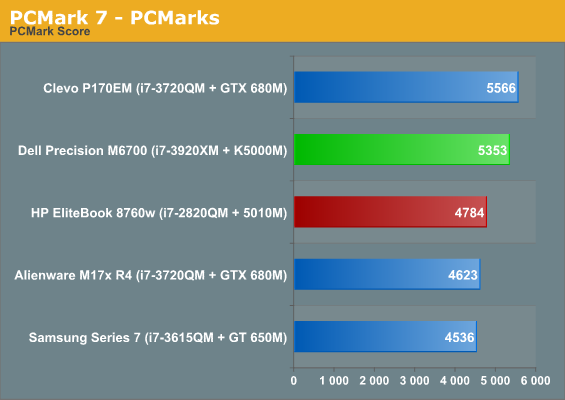

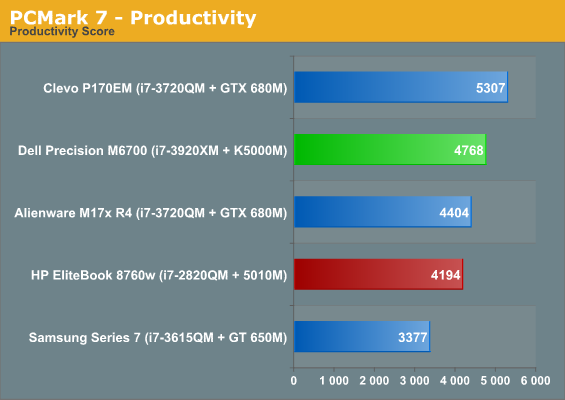
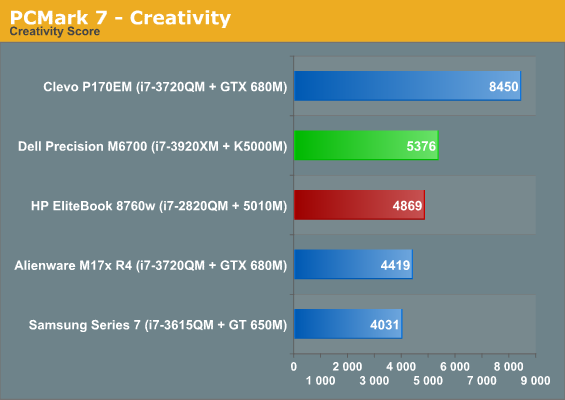
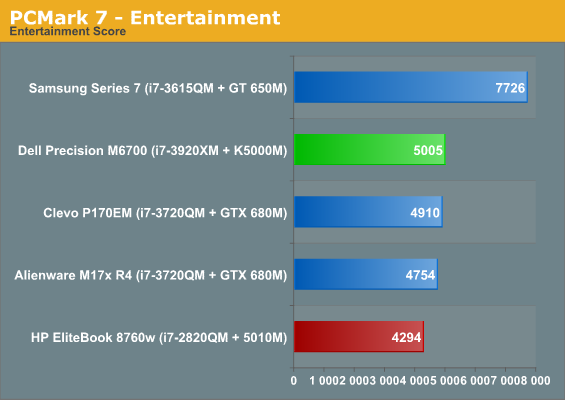
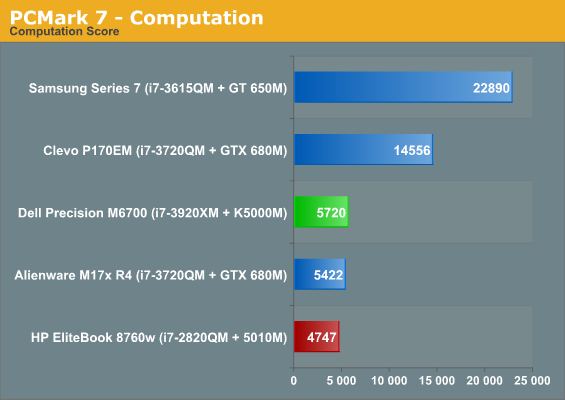
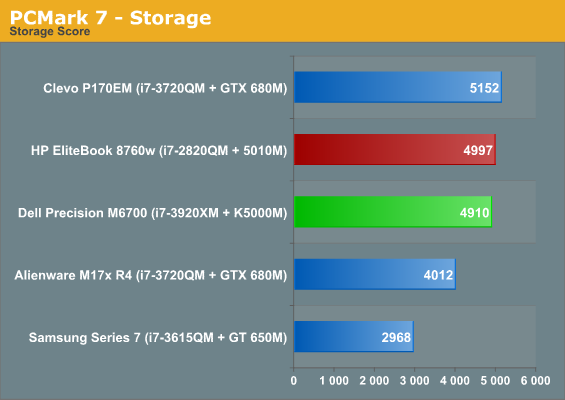
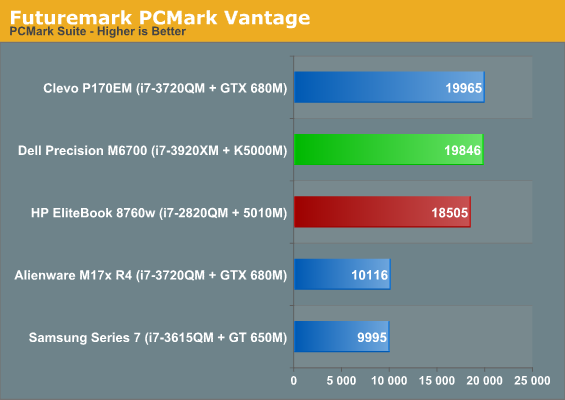
So what happened? It looks like PCMark slightly favors the Crucial m4 SSD the Clevo notebook uses. That's unfortunate, and frustrating, as once again PCMark shows it skews so hard towards the SSD that a system with a substantially more powerful CPU (lack of access to QuickSync notwithstanding), the Dell Precision M6700, is somehow eclipsed by a gaming notebook. But then I've been campaigning to remove PCMark from our testbed for some time now.
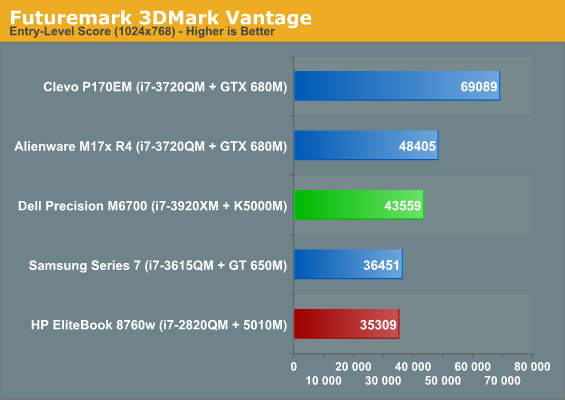
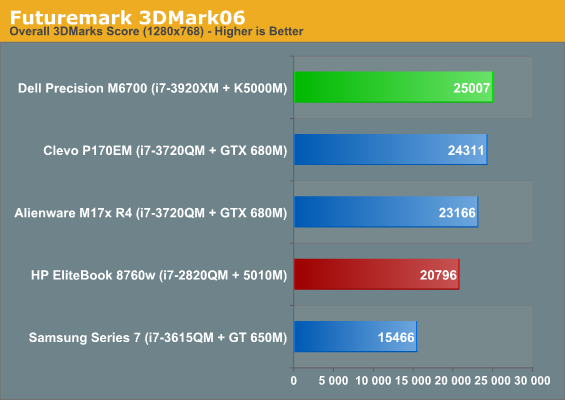
3DMark06 at least reveals the substantial performance of the i7-3920XM.
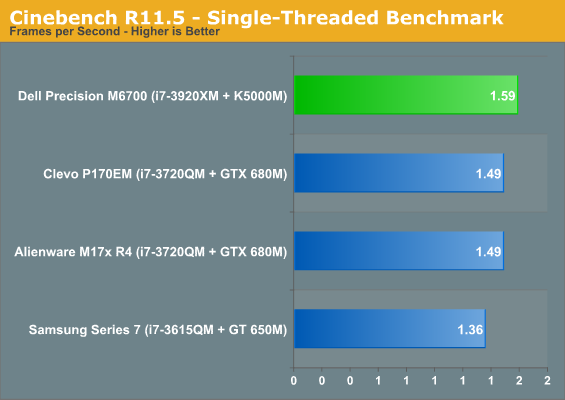
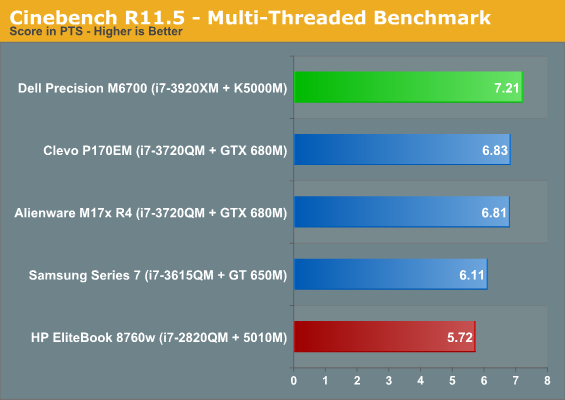
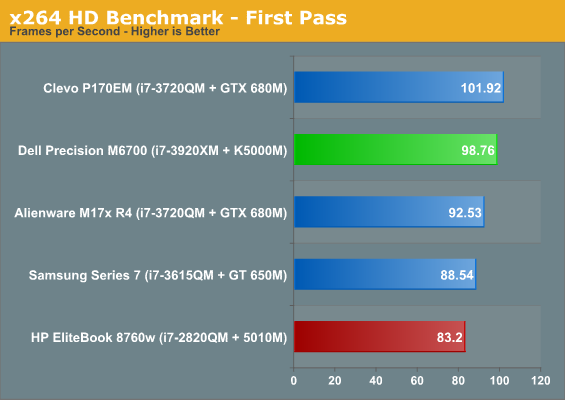

Inexplicably, Clevo's P170EM is able to produce better first pass results in our x264 benchmark, but in all other cases the M6700 is faster. For comparison sake, a stock i7-3770K (the one in the HP h9 Phoenix) is able to produce 100fps in the first x264 pass and 40.51fps in the second; that means that Intel's fastest (well, second-fastest now that the i7-3940XM is available) mobile chip is actually able to nip the heels of their fastest mainstream desktop chip. That also means that the 100MHz bump to the 3940XM is probably enough to get it to 3770K-level performance, which is frankly astonishing.










125 Comments
View All Comments
spiceshaper - Friday, December 14, 2012 - link
Kid, buy you that MBP and be happy, stop trolling the comments here. Yes, my M4700 (15") is almost as big as my old 17" MBP. But it costs half the price (and would cost at least 1.5k less than lesser equipped current Retina MBP), has 32GB, a 830 SSD and makes me happy every day I don't start iphoto and chose some serious software instead. It weights a ton, is bulky, but it gets shit done, none of the other options would be able to.I don't want pretty, I want something that helps me pay my bills.
They do the cooking, you just try to order something entirely not on the menu. Go to apple, they have that Michelin star.
hrrmph - Friday, December 14, 2012 - link
Nice try...But, Apple's 17" is still sporting a crappy display.
Why 'downgrade' to a 15" machine to get a better display?
Is no one capable of building a better 17" or 18" display?
-
PubFiction - Friday, December 14, 2012 - link
Is simple, the ability to put non workstation graphics in them. They would move a ton more units as gamers would start using them as conservative good looking well built gaming platforms. But they can never understand that so the price always ends up over $1000 more than a gaming notebook.It would add almost nothing to their supply chain as really the GPU is the only thing you need to swap out to save money. They even have 120hz displays which are lacking in even gaming laptops.
lx686x - Friday, December 14, 2012 - link
It wouldn't be a workstation anymore....ijozic - Friday, December 14, 2012 - link
It's just an extra customization option - some people don't need it for professional applications, but for occasional (or full-time) gaming as they dislike the design of the gaming notebooks. If that means sticking a big disclaimer sticker on the box saying "This is not a workstation anymore", I don't think anybody would mind.Silma - Friday, December 14, 2012 - link
I am quite astonished by this test.First to my knowledge Dell has been number one in the Workstation market for many many years and has produced great laptop workstations for years. My M4400 was and still is outstanding.
Second to say that the 6700 is not serviceable because you have to unscrew 2 screws for a change you rarely do is quite exxagerated.
Last I don't know on which planet you are living but the companies I worked for purchased workstations for a reason: power, robustness and certified for the applications that will be used. And not because they won a beauty contest. So to hesitate to recommend a robust laptop with very good screen and solid performances based on looks seems strange.
Hrel - Friday, December 14, 2012 - link
Lenovo Thinkpad's are the single best workstation laptops that exist. While I prefer working on Dell desktops over Lenovo, it's by a slim margin. Overall I'd always recommend Lenovo. Though Dell is honestly a close second, despite how much I hate their consumer offerings and general scheme of charging WAY too much for consumer products unless you're a student.Hrel - Friday, December 14, 2012 - link
I'd like to add that I'm in love with that keyboard layout. Every laptop made needs to adopt that RIGHT NOW! I prefer chicklet myself, so offer both. But that layout, damn sexy.critical_ - Friday, December 14, 2012 - link
I like ThinkPads too but I've owned the last two versionos of their W-series workstation laptop. The cooling solution is terrible. With a Core i7-2960XM and the Quadro 2000M, I found the system couldn't run full tilt for more than 60 seconds due to the single heatsink-fan used to cool the discrete GPU and CPU being overwhelmed. I even ordered a new heatsink-fan unit and used new thermal compound but that didn't solve this issue. The HP has the same issue.I believe Lenovo needs to redesign their cooling system on the W-series chassis. The engineers at Lenovo assume that we'll use Optimus so, at most, they're only going to be actively cooling either a CPU or discrete GPU running at full tilt but not both. Even then, the CPU will thermal throttle. When both are used them all bets are off.
Dell has done a great job with the cooling on this system. I seldom see any issue even when the intake vents are blocked. I can leave the CPU and GPU running full tilt for days without any thermal problems. The other great thing in the M6700 is the Core i7-2920XM and i7-2960XM will run at the 4C Turbo speed forever under these situations even though there are no overclocking options in the BIOS. It is these things that a review like this cannot or does not test but should. Maybe AnandTech should add a 24 hour rendering test that utilizes the CPU and discrete CPU together and then let us know how quickly and how often the unit thermal throttled in addition to telling us how much work was accomplished in that time period.
Maraque - Friday, December 14, 2012 - link
I come to Anandtech because you used have one of the most objective reviews around. I usually prefer to be a silent reader and refrain from making comments. But this has got to be one of the most biased analysis I have ever read in any Anandtech review. After everything the benchmarks said, that the Dell outclasses the HP in all of the benchmarks (the one reviewed anyway, not the 8770w), he still rates the HP higher just because it looks better (subjective). the HP is also a great machine, no doubt, not dissing it. But if he has already made up his mind as to which business notebook is better right out of the gate based on just its looks (contrary to what actual businesses buying these types of laptops do, which base their decision on the performance, build, serviceability, certifications, etc.), I do not see what right he has to review machines like these. I would recommend a reviewer who actually has an idea of the target market for these types of systems.